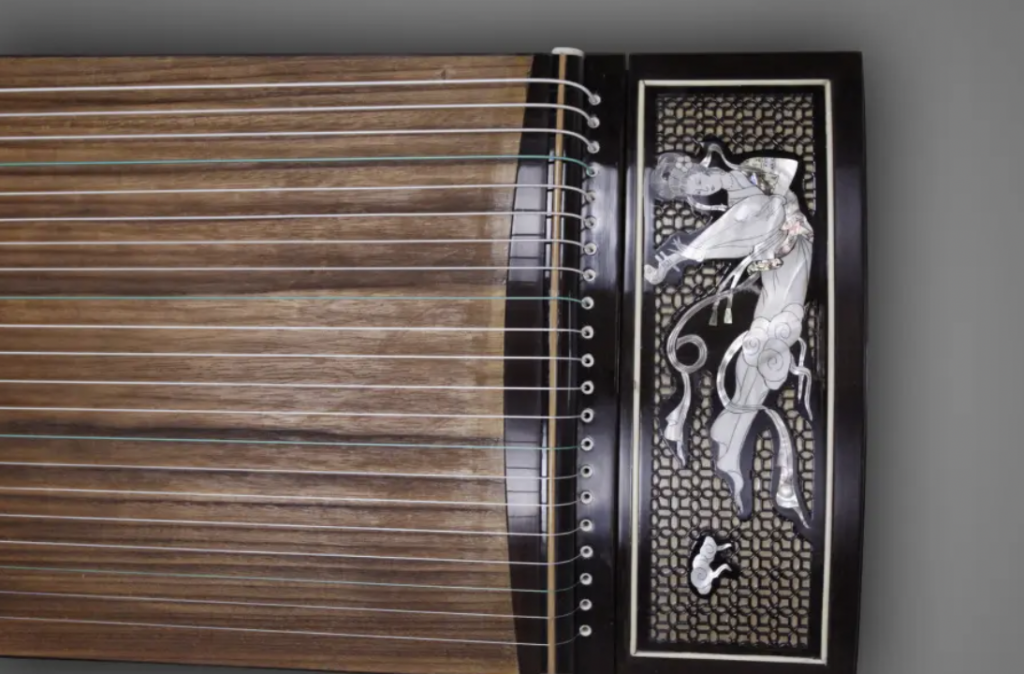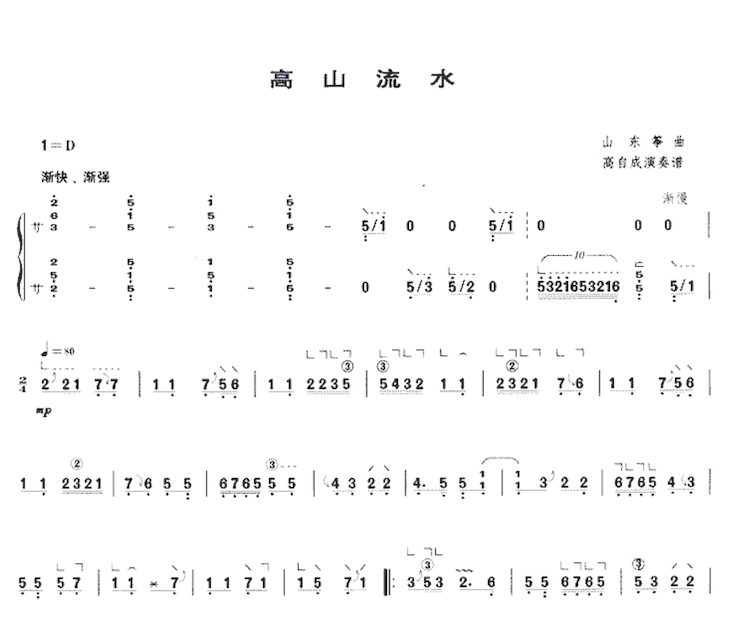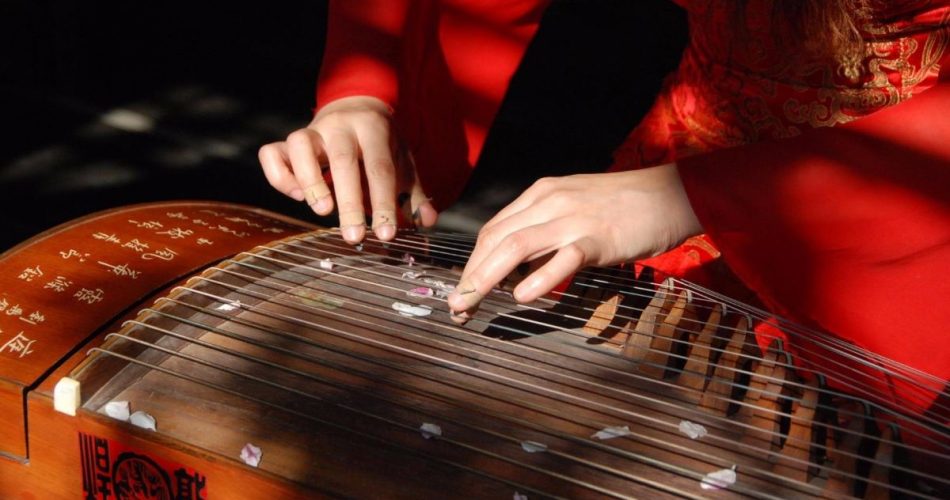Table of Contents
- The Definition of Guzheng
- The Origin of Guzheng/Zither
- The Strings of Zither
- Styles of Zither
- Summary
- FAQ about Chinese Guzheng
The Definition of Guzheng
Guzheng is the plucked zither in China. It is a zither-like stringed instrument with at least 18 strings and moveable bridges. Played with a plectrum, Guzheng originates from the traditional music of China.
Guzheng can be an instrument that is relatively easy to pick up for beginners. It is an ancient folk instrument of the Han people, popular throughout China.
Guzheng players often play it for solo, repertoire, instrumental ensemble, and accompaniment of songs, dances, operas, and operettas.
Guzheng is known as the “king of music” and “oriental piano” because of its wide sound range, beautiful tone, rich playing skills, and strong expression.
The Origin of Guzheng/Zither
Guzheng originated in the Warring States period and was popular in Qin, so it is also called Qin Zheng. The early Guzheng was made of five strings and the body was made of bamboo in the form of “Zhu”.
With a history of over 2500 years, Guzheng was initially a kind of weapon in the Warring States period. Later, people tried to add strings to this kind of weapon. Therefore, the weapon evolved to be a musical instrument.
However, while weapons became more lightweight, Guzheng was deserted as a kind of weapon. That is why Chinese people deem the Guzheng more of a musical instrument than a weapon.
There are different stories about the origin of Guzheng. It is said that Guzheng as an instrument was invented by Meng Tian (a general in the Qin Dynasty).
In line with the records in Shuowen Jiezi, an ancient Chinese dictionary discussing Chinese characters, Guzheng was initially a bamboo-tube zither.
Differently, some people also believe that Guzheng was born when two people fought on Se, a type of ancient plucked zither originating from China. After the fight, one person in this fight gained a 12-string part of Se, and another received 13 strings of the Se. Accordingly, Guzheng came out of Se.
This traditional musical instrument in China can be the origin of many zithers in Asian countries such as the Korean ajaeng and Japanese koto.
The Strings of Zither
According to ancient records, there were 12 strings of Zither. In the modern age, there are 21 strings. The modern Guzheng has 21, 25, or 26 strings in 64 inches. As time goes on, Guzheng is tuned in a major pentatonic scale.

Different genres of Guzheng have different strings such as steel strings and silk strings. Usually, the low-pitched strings are away from the player, while the high-pitched strings are close to the player. From the inside to the outside, the order of the string ranges from 1 to 21.
In different regions and different periods, people play Guzheng using different techniques with the strings.
Styles of Zither
There are different styles of Guzheng in different regions. In China, there are Shandong, Chaozhou, Hakka, Zhejiang, and Fujian styles of Guzheng.
Shandong Zheng
Shandong zheng originated from time-honored musical traditions. As a member of the string quartets introduced in the Qing dynasty, Shandong zheng is usually played along with “qing shu”, a kind of folk art pairing with Guzheng in this area. Shaodong zheng can also be solo.
While playing, Shandong zheng player often uses his or her left hand to mimic the singing of vocalists and uses the right hand to play the zheng with strength on tremolos.
Representative Shandong Zheng Songs:
High Mountain and Flowing Water
Autumn Moon over the Han Palace
Big Ten Beat

Chaozhou Zheng
Chaozhou zheng features distinctive modes and highly embellished melodies. Compared with other styles of zheng, Chaozhou zheng adopts greater movement with a larger sound. Players following the style of Chaozhou zheng use their right hands to complete complicated operations such as fingers striking the string to generate different sounds.
Representative Chaozhou Zheng Songs:
Lady Zhaojun’s Lament
Adding Flowers to Colorfulness
Great Eight Beats
Hakka Zheng
Hakka zheng shares similarities with Chaozhou Zheng. However, the Hakka zheng has fewer embellished techniques than the Chaozhou zheng. There are soft and stiff strings in Hakka zheng. The stiff string boasts smooth and plain flowing, while the soft string has classic beats that are usually more fragile.
Representative Hakka Zheng Songs:
Sorrow of Madam Zhaojun
Red Little Peach
Jade Ring
Thousands of Miles
Zhejiang Zheng
Zhejiang zheng features a more powerful sound than other styles of Guzheng. Zhejiang zheng requires the players to use two hands to pluck the strings, symbolizing Chinese guzheng players’ embracing western music techniques. Players usually adopt this style of zheng in composing new zheng songs.
Representative Zhejiang Zheng Songs in China:
Cloud Celebration
The High Moon
The General’s Command
Fujian Zheng
Many Fujian zheng songs borrow from Hakka and Chaozhou styles of zheng. Emphasizing the characteristic of simplicity with fewer embellishments, Fujian zheng is different from Chaozhou zheng in that the former emphasizes simplicity, while the latter stresses more embellishments.
Representative Fujian Zheng Songs:
A Dragonfly Touching Lightly on the Water
Casually Leaning on the Rail
Summary
In this post, people can learn details about a Chinese musical instrument, Guzheng, from its definition and origin to its style. You can understand the strings and features of different styles in different regions in China.
FAQ about Chinese Guzheng
Guzheng vs Se
Guzheng refers to a Zheng musical instrument that belongs to the plucked instrument, while Se is a kind of playing board and box stringed musical instrument in ancient China. To some extent, Guzheng originated from Se.
Guzheng vs Guqin
The major difference between a Guzheng and Guqin lies in the number of strings. That is, a Guzheng has 21 strings, while a Guqin only has 7 strings. Guqins are much smaller in size.
Is Guzheng and Koto Same?
Guzheng and koto come from the same instrument family. However, they are much different in detail. For instance, modern koto has 13 strings with all strings in the same thickness and tension, while a modern Guzheng has 21 strings with different thicknesses and tension.
What is Guzheng Called in English?
Guzheng is a shockingly beautiful long zither in China. The name for Guzheng is called “ancient Zither” or just “Guzheng” in English.
Is Guzheng Difficult to Learn? Can I learn to Play Guzheng all by myself?
It is relatively easy to learn Guzheng, and learners can play it without musical background.
What are the four popular string Quartets in China?
The four string quartets in China are Shaodong zheng, pipa, xiqin, and Yangqin.
Is the Guzheng a Harp?
The Guzheng is often described as a Chinese harp by westerners. However, in fact, in China, harp often means the “Konghou”, so it would be better to call Guzheng a Chinese zither. A harp usually has a soundboard or resonating chamber perpendicular to the strings, while a zither has a soundboard parallel to the strings.
How Many Strings Does a Harp Have?
The harp is a unique instrument, and the modern harp has 47 strings and 7 pedals that raise or lower each pitch class of strings.
